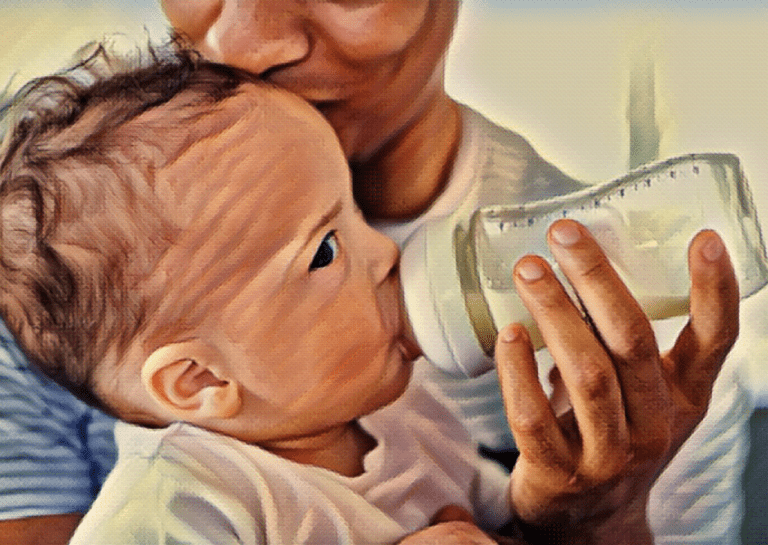While breastfeeding is universally recognized as the best choice for both mother and baby, it´s not suitable in every case. Bottle feeding with either expressed breastmilk (breastmilk extracted with a breast pump) or baby formula is a feeding method that can be combined with nursing or used exclusively if breastfeeding is not possible.
However you choose to incorporate bottle feeding, it’s important to understand your options and to know the correct feeding techniques to keep your baby safe and healthy.
Breast milk vs formula
Deciding whether to feed your baby breastmilk or formula can depend on a number of factors, including the health and medical history of the mother and the caretaking arrangements.
Breastmilk
Breastmilk is the best source of nutrition for your baby. It provides them with most of the vitamins and nutrients they need to thrive in early life. Breastmilk can protect your baby from infection and disease and promote optimal gastrointestinal development and function. The many benefits of breastmilk manifest in both the short and long term.
While there are very few reasons why breastmilk should not be used, there are some situations in which it is not recommended. Breastmilk is not recommended if the mother:
- Is receiving treatment for cancer
- Has HIV
- Uses illicit drugs
- Has a suspected or confirmed Ebola virus infection
Formula
Baby formula is a suitable alternative to breastmilk because it is fortified with the vitamins and minerals your baby needs. However, formula can never truly match the nutritional complexity of breastmilk and its ability to protect against disease. It´s still a good option if breastfeeding is not possible and can be more convenient if the baby is in the care of a friend or relative, for example.
When to start bottle feeding
For breastfed newborns, bottle feeding should not be introduced for at least 2 to 3 weeks as doing so any earlier could affect the production of breast milk. On the other hand, introducing the bottle too late could pose weaning problems as the baby may find it hard to adapt to an artificial bottle teat.
Bottle-feeding guidelines
Equipment
Ensure bottle-feeding equipment, such as bottles, teats, and bottle brushes, are regularly sterilized when feeding babies younger than 12 months.
Feeding frequency
Babies should be fed regularly to avoid hypoglycemia or low blood sugar. There should be no more than 4 hours between feeds.
Bottle preparation
Babies generally prefer to be fed warm milk, but there is no reason that they cannot drink it cold. If you are using freshly expressed breastmilk, you should not need to warm it before feeding. For cold breastmilk or formula, you can heat the bottle using a warm water bath. Avoid submerging the whole bottle in water or leaving it in a warm water bath for more than 30 minutes.
Do not use a microwave to warm bottles as this can impair the nutritional properties of the milk. Always check the temperature of the milk before feeding it to your baby. You can do this by sprinkling some milk on your wrist or forearm. Do not use your fingers to test the temperature as the skin is less sensitive and more resistant to heat, giving you an inaccurate impression of the bottle temperature. The milk should be lukewarm, or around 98˚F.
Bottle-feeding technique
For feeding time, find a place to sit that will allow you or your partner to comfortably support your baby for the duration of the feed — around 15 or 20 minutes. Remember to support the baby’s head and neck with the crook of your elbow and hold the bottle at a slight angle to facilitate the flow of milk but to prevent choking.
Babies generally start with 2 to 3 ounces of milk per feed. This amount will gradually increase as they grow and show increased hunger. Feed your baby as much as they are hungry for, and don’t try to give them more than they can comfortably take.
References
Sachs HC; Committee On Drugs. The transfer of drugs and therapeutics into human breast milk: an update on selected topics. Pediatrics. 2013 Sep;132(3):e796-809. doi: 10.1542/peds.2013-1985. Epub 2013 Aug 26. PMID: 23979084.
Section on Breastfeeding. Breastfeeding and the use of human milk. Pediatrics. 2012 Mar;129(3):e827-41. doi: 10.1542/peds.2011-3552. Epub 2012 Feb 27. PMID: 22371471.
Williamson MT, Murti PK. Effects of storage, time, temperature, and composition of containers on biologic components of human milk. J Hum Lact. 1996 Mar;12(1):31-5. doi: 10.1177/089033449601200108. PMID: 8715236.
